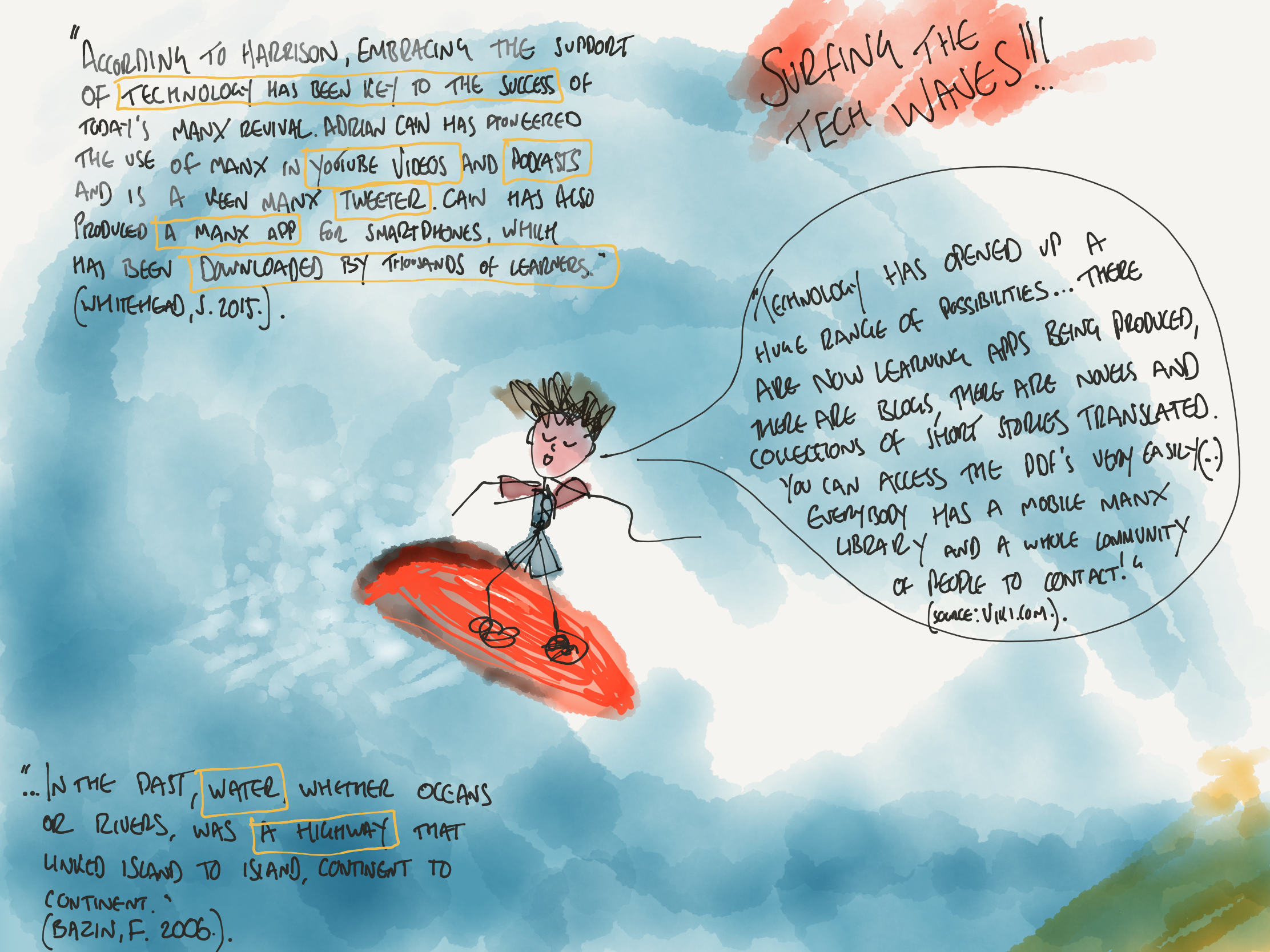Manx culture and language was on the brink - how did the ‘digital waves’ inspire it to not become extinguished?
I have been studying the Celtic nation The Isle of Man over the past few weeks. The Island is located in the Irish Sea at the geographical centre of the British Isles. It is estimated that it came into being around 8,500 years ago when rising sea levels caused by melting glaciers cut Britain from continental Europe. A land bridge used to exist between the Isle of Man and Cumbria before then and the island has been inhabited by humans ever since. In this blog post, I will continue to offer some water based imagery to help me surf the digital waves as I look into what inspired the arts and cultural sectors in The Isle of Man to resurrect its Celtic culture, music, dance and language - bringing it into the new.
The Isle of Man is, I would argue, slightly unlucky in the sense that it has indeed been a prominent site of Celicity, yet it lacks some of the foundations that the other nations of the movement can claim with ease. This means that it is a much bigger ask to assert its place in the movement, some may argue. This suggestion can be asserted by the late Doug Fargher (author of the Manx-English dictionary) likened the health of the language to ‘a flickering flame that could be extinguished with one blow.’ This fragility inspired creative minds on the Island to take action. This fragility can also be creatively advantageous, I would argue. The Island was a place where multitudes were mixed:
Manx folk songs are less distinctive in character than those of Ireland
or Scotland, probably because so many races have left their
impression on the Island - from the Iberians, Celts, Danes, and
Norsemen, down to the Scots and the English.
(Graves, R. 1921.).
To come back to my former point about its foundations being less recognisable and unique, The Isle of Man interestingly has no identifiable national instrument which is unlike the other Celtic Nations.
Speaking on the effect of musical instruments on the folk songs
of a nation (…) there were no traces of the harp to be found in
Manx folk music, nor were there any melodies on the pentatonic
scale, such as are found in countries where the bag-pipes are
the predominant national instrument.
(Graves, R. 1921.).
I find this particularly interesting in the business sense. The Isle of Man has to work harder to promote its culture and music through the songs and the poetic lyrical content, without the option to sell something tangible to accompany it. Is this one of the reasons why some of the Celtic sensibilities were on their way out?
It also has to be said that The Isle of Man was the battle field, as it is now the summer playground, of its surrounding nations. Each of its inhabitants over the many years have left its mark upon the character of its people, their language, their surnames, their place-names, and their ancient institutions.
There is no denying the powerful, emotive pull of the waves and the water that surrounds the Isle and how this elemental force seeped its way naturally into the lore, music and dance - regardless of race. I reflect fondly on this notion as I look back to my own composition prior to my research into The Isle of Man and how I was inspired by similar concepts. For instance, the Celtic god of the sea Manannan Mac-y-Lierr is said to protect the Island with his magical cloak of mist. The terms ‘magical’ and ‘mystical’ continue to assert JRR Tolkien perspective that the Celt and with it The Isle of Man can be a ‘magic bag into which anything may be put.’ I would firstly like to introduce an illustration by freelance artist Juan Moore, via the Isle of Man Steam Packet Company’s Map of Fantastical Folk of the Isle of Man to set the scene for some songs of the sea, before looking at how digital waves were surfed, resulting in the re-lighting of the Manx identity.
Moore, J. 2020. Celtic God of the Sea - Isle of Man
Lots of songs were devised in response to the sea and its danger, mystery and might. Here is one of my favourites that I found during my research called “Sea Invocation” - a song of the sea sung by those sending well wishes to those out in its midst, chiefly fisherman’s wives praying for their husbands safe return:
Here is another that has fascinated me named “Three Little Boats” this time complete with a traditional Manx dance which I would argue certainly connotes and denotes some of anecdotal norse aesthetics. Musically, it is safely set in the minor pentatonic idiom, which is interesting when paired to what seems like a celebratory and somewhat joyous choreography:
As you can see, there is certainly a strong sense of traditional Manx music and dance inspired by the magic of the sea waters which has been preserved… somewhat. Rosaleen Graves confirms this feeling of the “somewhat” which I alluded to, describing the one reason for the people forgetting the music:
Their traditional airs are sung almost like plainsong, the rhythm
being disguised by long-drawn-out notes and pauses to
emphasise points in the story being sung. (…) The result,
however, of this manner of singing, in which the tune is
subservient to the words, is that once the words are
forgotten, the tune is lost also.
(Graves, R. 1921.).
Of course, we cannot forget the might of the British who insipidly cast a shadow on The Isle of Man’s traditional language and song - often discouraging youths from it in the school context where I would argue a great deal of learning about culture and identity can be gleaned. The documentation of songs in contrast to other Celtic Nations is not so easily traceable. There is certainly plenty of detritus which was washed up and had to be re-contextualised to suit the context as Chloë Woolley explains in her thesis:
As displayed in the Gill and Clague manuscripts, the original words,
for whatever reasons, were rarely collected, so there was little
reference for the lyricists, apart from song texts previously printed
in Manx Society Publications. Instead, typical ‘Manx national
features’ became the thematic content, and references to
place-names, Manx surnames, customs and heroes common to
the Isle of Man were used throughout. Therefore, the context of a
traditional song was often transformed to enhance the ‘national’
element of the songbook. For instance, the lyrics for “King of the
Sea”, a song about herring, one of the main industries in the Isle
of Man during the 18th century, were set to two variant melodies
(major and minor versions) which were originally about a
speckled heifer.
(Woolley, C. 2003.).
Woolley’s notion that the ‘context had to transform’ is a fascinating and current one - it has certainly been followed through in more recent times, resulting in the re-lighting of the Manx language for instance and its inherent identity through the riding of the digital waves! Manx as a language was officially declared extinct by UNESCO in 2009, though my illustration below gives way to some of the ways in which the language was able to be saved, remembered and revitalised:
Surfing the Tech Waves!
It is through the voice of the youth that a culture, brave enough to step out onto the metaphorical choppy seas, that a language and a movement, if you will, can grow through music and the arts. I am able to recognise this excitement and momentum in some of the young artists of The Isle of Man today, such as Mera Royle manages with this beautiful rendition of Arrane Ghelby - a traditional Manx harp tune:
This piece also has a significantly sonic link to the sea. In this video’s information section online, Culture Vannin shared that Sophia Morrison first published the tune of 'Arrane Ghelby,' in the journal ‘Mannin’ in 1913, where she reported the story told to her by Mr. T. Quane, of Dalby:
"In the long ago a curiously shaped boat would be seen at the close of a summer evening coming from Bradda towards Dalby. In the boat sat an old man with long white hair, who rowed until off Niarbyl Point; there he rested on his oars and sang this melody, which runs up and down the minor scale with the lilt of the waves. And as the thing became known, the people would come and stay on the shore to listen to his music, for it was very sweet to them; but his boat was far off, and no words could be distinguished. When the old man had made an end of the song, he rowed south-westward till he was seen no more. And no one knew whence he came, nor whither he went, nor who he was, but the people of Dalby knew his song and taught it to their children’s children."
Just as the water in the sea weathers through changes, I have no doubt this is an exciting moment for The Isle of Man and other perceived minorities, to grasp the mantle and embrace the tides to continue to expand its vision for a contemporary, Celtic identity! This, coupled with the imagery of the sea water, could be very intriguing grounds for further research - with the opportunity to bring in stories, old and new, into livings rooms where the family can rejoice in their identities - much like mine.
References
Culture Vannin, 2017. Arrane Ghelby: A traditional Manx harp tune played by Mera Royle. Available From: https://www.youtube.com/watch?v=zxis5LLvULw&t=48s&ab_channel=CultureVannin Accessed November 20 2020.
García, Pedro Fernández. 2012. Three little boats went out to the sea. Available from: https://www.youtube.com/watch?v=ymJRprRdCUo&ab_channel=PedroFern%C3%A1ndezGarc%C3%ADa Accessed December 10 2020.
Graves, Rosaleen. 1921. The Celtic Congress in the Isle of Man. The Musical Times Vol. 62, No 942 pp 583 - 585. Musical Times Publications LTD. Available From: https://www.jstor.org/stable/910040
Moore, Juan. 2020. MANANNAN’S MAP OF FANTASTICAL FOLK OF THE ISLE OF MAN… Available from: https://www.steam-packet.com/blog/manannans-map-of-fantastical-folk-of-the-isle-of-man/?fbclid=IwAR2lve1V7d_KJI9JYDdyglxZJN2Q4maKeng7Macz8enkMlaLUgvvloGOdvs Accessed December 12 2020.
Sea Invocation, performed by Caarjyn Cooidjagh. 2017. Available from: https://www.youtube.com/watch?v=O98Ss3cr03M&ab_channel=CultureVannin Accessed December 10 2020.
Woolley, Chloë. 2003. The Revival of Manx Traditional Music: From the 1970s to the Present Day. The University of Edinburgh. Available From: https://www.manxmusic.com/media/History%20photos/Revival%20of%20Manx%20Trad%20music%20PhD%20thesis%20C%20Woolley.pdf Accessed December 10 2020.


